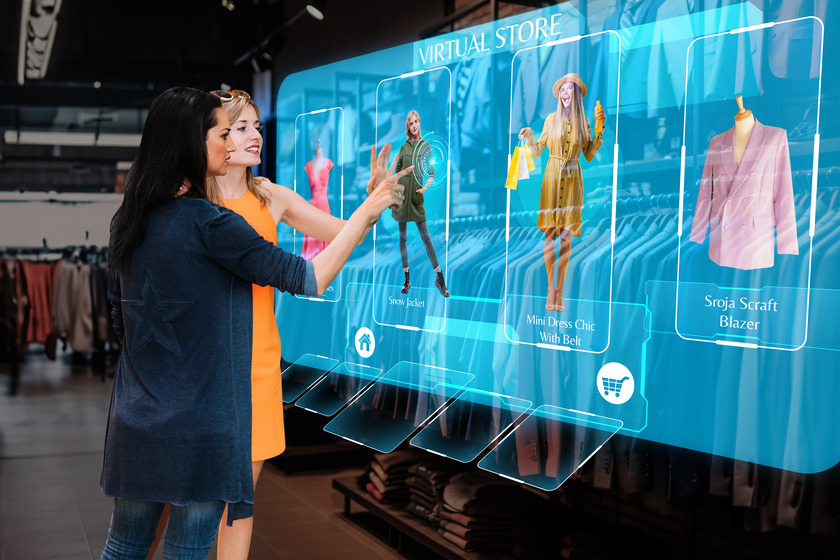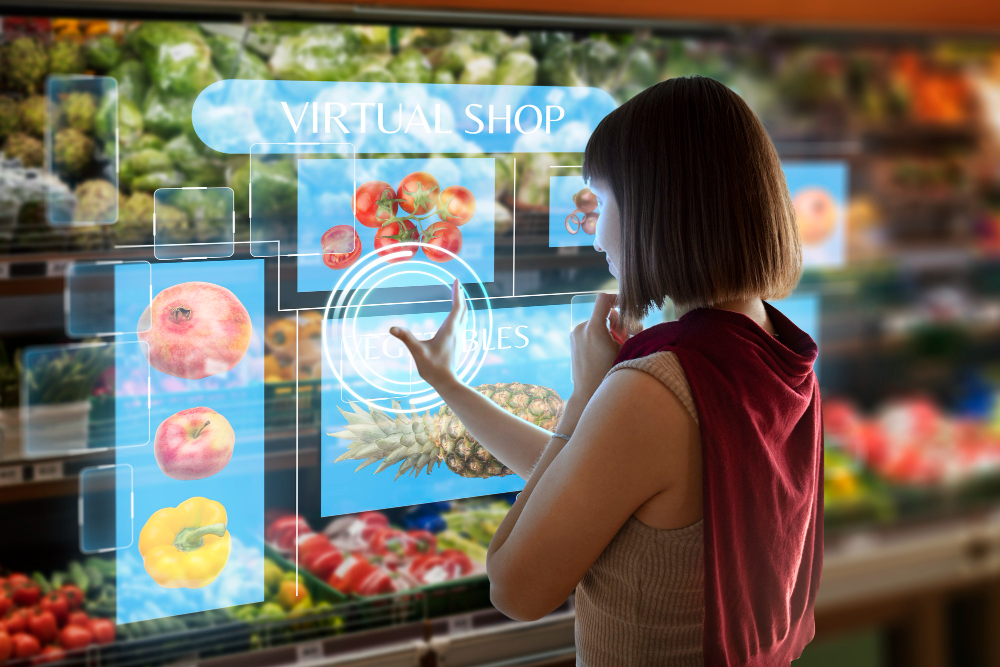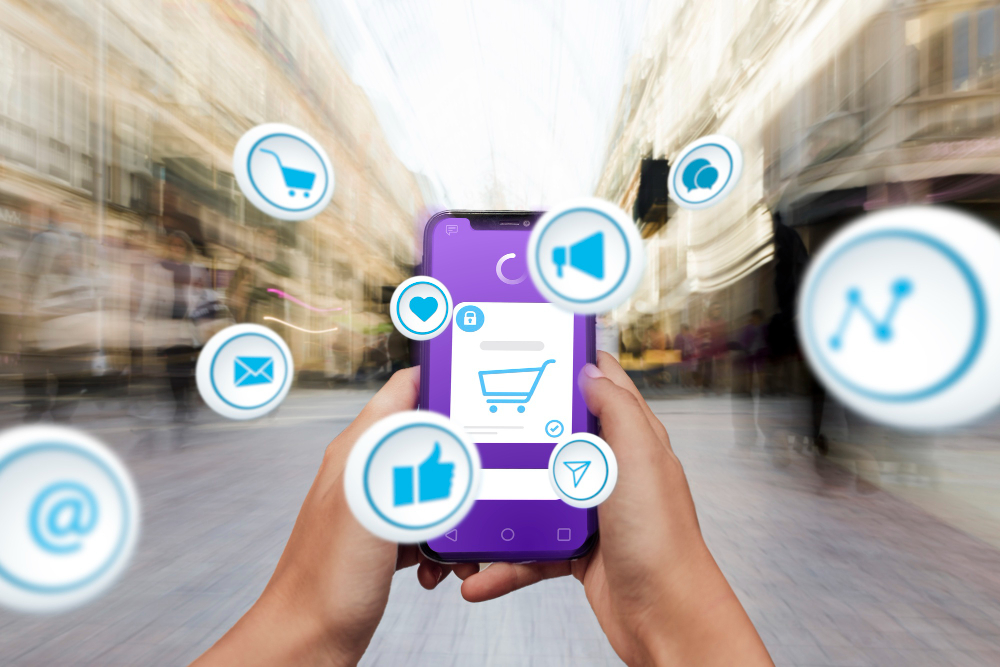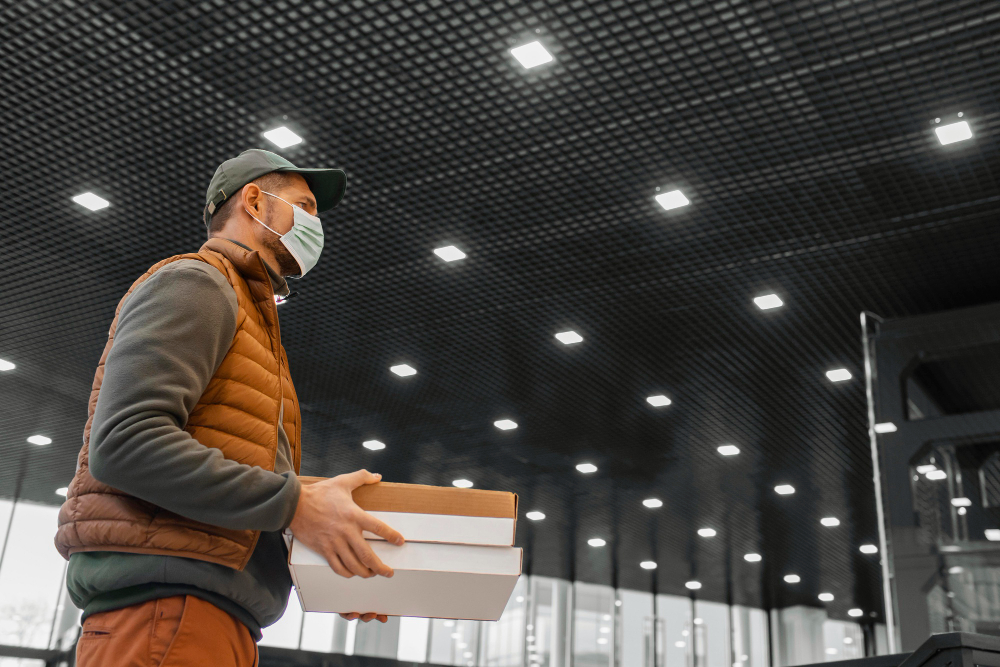
Shaping the Future of Shopping.
The Retail world is changing fast because of new technology, what people like, and the world’s economy.1 Today, it’s crucial for the industry to understand and use these new trends. This way, they can be successful in the future.
Retailers must blend their online and offline stores well. This is crucial because customers want an easy experience no matter where they shop. Great retailers use tech that makes switching between shopping channels easy. This makes shopping better for customers and keeps them loyal.
Retailers are now using AI and data to make shopping more personal. They make product suggestions and offers that fit each customer’s style. They do this by learning what each customer likes and needs. This makes their shopping experience more special.
Key Takeaways
- Retail sector is undergoing significant technological and consumer-driven transformations
- Seamless omnichannel experiences are essential for engaging customers and building loyalty
- Personalization through data analytics and AI enhances the customer shopping journey
- Retail media advertising plays a pivotal role in introducing new brands and products to consumers
- Ecommerce and mobile commerce are growing at a faster rate than physical retail sales
Seamless Omnichannel Experiences: A Game-Changer.
Retail is changing fast. It’s now key for shops to work well online and in person. People want a smooth experience no matter if they’re online, in a store, or on an app. 73% of shoppers like using different channels, and they spend 30% more over time.

Integration of Online and Offline Channels.
Good stores use tech to make moving between online and in-person shopping easy. This gives customers what they want most: convenience and choices. Across all types of products, 60 to 70 percent of people look and buy both in a shop and online. Many store bosses think it’s vital to offer a smooth experience everywhere in 2022.
Providing Convenience and Flexibility.
Mixing online and in-store shopping gives people the choice to browse and buy how they like. More than half say they check out what they want to buy online, then get it at the store. About the same amount likes to see things in a store, then buys them online. Also, almost half make sure what they want is in stock online before heading to the shop. Among young shoppers, 60% sometimes or always look up what’s in stock online before shopping in person.

Enhancing Customer Engagement and Loyalty.
This way of shopping is not just about ease and choice. It also makes customers more interested and loyal to brands. A big majority—76 percent—wants a smooth experience across all parts of a store. Many people in the e-commerce world see this as a big deal. Over half like shopping in real stores, and nearly half think having a shop nearby is important in choosing where to shop.
By turning their shops into a seamless mix of online and offline, different brands stand out. They make customers happier and more loyal.2 This way of mixing online and in-store shopping is changing how shops work. It’s a big deal in retail.
Personalization: Tailoring the Shopping Journey.
Retailers are now using data analytics and AI to make shopping personal. They match products and deals to what each customer likes. This makes shopping more fun and encourages people to stay loyal to the brand.
Data Analytics and AI-Driven Personalization
Advanced data analytics and AI are changing the way we shop. They look at what customers do and like. Then, they suggest things just for them. This way, shopping feels like it’s made just for you. Retailers use this info to make ads and offers that really grab your attention.
Customized Product Recommendations
It’s not just about ads. Retailers also show us things we might really want. They use AI to pick out items based on our past choices and what we seem to like. This approach helps customers find and buy things they love. It also keeps them coming back.

Targeted Marketing Campaigns.
Making ads personal is key to keeping customers interested. Retailers create ads, deals, and reward programs just for you, using data and AI. This means you see stuff that really speaks to you. It may even make you want to buy.
Retails Network Trends in US: Driving the Future.
The retail world is changing fast. Thanks to cloud computing and strong network infrastructure, stores can run better and get info right away. They use big data analytics to learn about what customers like. This helps them offer things customers want and make smart choices. But, as everything goes digital, keeping customer info safe is a big worry. Cybersecurity and data privacy are now top issues for stores. They need to work hard to protect their shoppers’ trust.
Cloud Computing and Network Infrastructure.
Stores are using cloud computing and great networks to get ahead. This makes their work smoother, helps their supplies come faster, and lets them decide based on what customers need. Cloud computing and network infrastructure are fundamental to modern information technology, driving innovation and efficiency across various sectors. Cloud computing enables on-demand access to a shared pool of configurable computing resources, such as servers, storage, applications, and services, which can be rapidly provisioned and released with minimal management effort. This paradigm shift from traditional on-premises data centers to cloud-based solutions has revolutionized how organizations deploy and manage their IT resources, offering scalability, flexibility, and cost savings. By leveraging cloud services, businesses can quickly adapt to changing demands and market conditions without the need for significant upfront capital investment.
The underlying network infrastructure plays a critical role in the seamless delivery of cloud services. Robust and reliable network infrastructure ensures that data can be efficiently transmitted between users and cloud servers, maintaining high levels of performance and availability. Key components of network infrastructure include physical hardware such as routers, switches, and fiber-optic cables, as well as virtualized network functions that optimize traffic flow and security. Advanced technologies like software-defined networking (SDN) and network function virtualization (NFV) have further enhanced the capabilities of network infrastructure, enabling more agile and responsive network management.
To enhancing business operations, cloud computing and network infrastructure have significant implications for innovation and collaboration. With cloud-based platforms, developers can access cutting-edge tools and environments to build, test, and deploy applications more rapidly. Collaborative tools hosted on the cloud facilitate real-time communication and coordination among geographically dispersed teams, breaking down barriers to productivity and creativity. Moreover, the integration of artificial intelligence and machine learning with cloud services is driving the development of intelligent systems that can analyze vast amounts of data to derive actionable insights, thus transforming industries ranging from healthcare to finance. In essence, the synergy between cloud computing and network infrastructure is paving the way for a more connected and technologically advanced future.

Cybersecurity and Data Privacy.
Cybersecurity and data privacy are crucial concerns for businesses today, especially in the retail sector where customer trust is paramount. As stores increasingly rely on digital platforms for sales and customer engagement, the need to protect sensitive information from cyber threats has never been more urgent. Cybersecurity involves a range of practices and technologies aimed at safeguarding networks, devices, and data from unauthorized access, attacks, and damage. Implementing robust cybersecurity measures, such as firewalls, encryption, and regular security audits, helps prevent data breaches that could compromise customer information. For retail businesses, maintaining strong cybersecurity is not just a technical necessity but a strategic imperative to preserve their reputation and customer loyalty.
Data privacy is another critical aspect that retailers must prioritize alongside cybersecurity. With the growing concerns over how personal information is collected, used, and shared, businesses are under increasing pressure to comply with data protection regulations like the General Data Protection Regulation (GDPR) and the California Consumer Privacy Act (CCPA). These laws require companies to be transparent about their data practices, obtain explicit consent from customers, and provide them with control over their personal information. By adhering to these regulations, retailers not only avoid legal repercussions but also build trust with their customers, who are more likely to feel secure and valued when they know their data is handled responsibly.
The stakes for neglecting cybersecurity and data privacy are high, as any lapse can lead to severe consequences, including financial losses, legal penalties, and damage to brand reputation. A single cyber attack can result in significant data breaches, exposing sensitive customer information and eroding trust. When customers lose confidence in a store’s ability to protect their data, they are likely to take their business elsewhere. Therefore, retailers must make cybersecurity and data privacy a top priority, investing in advanced security technologies and cultivating a culture of vigilance and responsibility. By doing so, they can safeguard their operations, foster customer trust, and maintain a competitive edge in the digital marketplace.

Sustainable and Eco-Friendly Retail Practices.
Consumer awareness of environmental issues is rising. This has made sustainability a top concern for many shoppers. In 2022, 93% of consumers kept or increased their sustainable buying habits. Additionally, about 70% of shoppers say sustainability matters more to them than the brand name.
Retailers are changing their ways to meet these new demands. They’re using eco-friendly practices in everything from where they get their materials to cutting down on emissions. This shows a shift towards more planet-friendly ways of doing business.
Eco-Friendly Sourcing and Production.
Choosing sustainability in retail not only attracts those who care about the earth. It also makes a real difference for our planet and society. For example, many retailers focus on using less harm-causing materials and shrinking their manufacturing impact.
The majority of a smartphone’s carbon footprint comes from how it’s made. This highlights why being eco-friendly in sourcing and production is crucial.
Sustainable Packaging and Logistics.
Retailers are not just stopping at materials and production. They’re also making sure that the way they package and send out their products is eco-conscious. More U.S. shoppers are looking for goods that are free from bad chemicals, showing a demand for safe packaging. To meet this, companies are turning to options that create less waste and can be recycled.
Improving shipping and distribution can also make a big dent in cutting down on harmful emissions. This is key because supply chains can be responsible for a huge chunk of a company’s greenhouse gases.
Corporate Social Responsibility Initiatives.
It goes beyond just the products themselves. Retailers now also work on improving the world around them. They do this by helping their local areas, making sure their workers are treated right, and giving to causes they believe in.
This effort to be socially and environmentally responsible helps them win over customers who really care about these issues. It builds trust and loyalty because people see the positive difference they’re making.
The push for sustainability in the retail world keeps getting stronger. By focusing on eco-friendly practices and caring about their effect on the world, retailers set themselves up for success. This is about meeting the changing needs of shoppers and working towards a future that’s better for everyone.

Innovative Delivery Solutions and Last-Mile Logistics.
Retailers are keen on finding new ways to deliver goods quickly and easily. They’re looking into cool options like drone delivery and self-driving cars. By making the last leg of a product’s journey more efficient, they hope to make shoppers happier and stay ahead of the pack.
It’s estimated that by 2028, the last mile delivery market will grow by nearly $61 billion. Companies are mixing their own delivery fleets with third-party services for better results. Take Amazon for example; their blend has cut costs and sped up deliveries.
Adding urban warehouses and tiny fulfillment centers is another path they’re taking. These setups aim to cut down on travel time and offer same-day delivery, which many customers are now expecting. A big chunk of shoppers, like, look for items to arrive within three hours of ordering. Around prefer receiving their products on the same day.
Using smart route planning software and other tech tools can also improve the delivery chain. These programs cut down on fuel use and the need for many delivery vehicles. Plus, the use of technologies like blockchain and the Internet of Things in deliveries could create huge value by 2025.
With the environment in mind, many companies are going green in how they deliver goods. They’re working on carbon offsetting, better routes, and the switch to electric vehicles. This is key to lessening the environmental impact of their operations.
By using new delivery methods and making their systems smarter, retailers can make customers happier, save money, and climb higher in the retail world.

Voice-Activated Virtual Assistants.
Voice-activated virtual assistants, such as Amazon’s Alexa and Google Assistant, have become ubiquitous in U.S. households, revolutionizing how people access information and manage their daily tasks. These devices offer a convenient, hands-free way to interact with technology, allowing users to ask questions, play music, control smart home devices, and much more. Their growing presence is transforming the home environment, making it more connected and responsive to the needs of its occupants. By integrating artificial intelligence and natural language processing, these virtual assistants are continually improving their ability to understand and respond to a wide range of user commands, making them indispensable tools in modern homes.
The convenience and efficiency of voice-activated virtual assistants have not gone unnoticed by businesses, particularly in the retail sector. Companies are increasingly incorporating voice shopping capabilities into their online stores, recognizing the potential to enhance the customer experience and streamline the purchasing process. With voice shopping, consumers can easily search for products, compare prices, and make purchases using simple voice commands. This technology reduces the friction associated with traditional online shopping methods, providing a seamless and intuitive shopping experience that can be accessed from anywhere within the home. As a result, businesses that adopt voice shopping are likely to see increased customer engagement and higher conversion rates.
The rise of voice-activated virtual assistants represents a significant shift in consumer behavior and expectations. As more people become accustomed to using voice commands for a variety of tasks, they will increasingly expect this level of convenience from the brands they interact with. Businesses that embrace voice technology not only stay ahead of the curve but also demonstrate their commitment to innovation and customer satisfaction. By integrating voice-activated features into their services, companies can gain valuable insights into consumer preferences and behaviors, allowing them to tailor their offerings more effectively. In this rapidly evolving digital landscape, voice-activated virtual assistants are poised to play a critical role in shaping the future of commerce and customer interaction.
Integrating Voice Commerce into E-Commerce Platforms.
Improvements in voice tech are making it easier to shop online by talking. This helps customers buy things with simple words. It also means stores can sell anytime, anywhere, without missing out on sales.
But, voice shopping faces some challenges. There’s the issue of voice accuracy and people’s privacy. Plus, it’s still hard to make sure your store shows up in searches. Despite these, voice shopping is expected to get even better. We’re looking at more personalized and easier ways to shop online.
Shopping through voice is fast becoming a big deal. It makes buying stuff online feel more personal and easy. Retailers that use this technology will offer better shopping times. They’ll meet their customers’ changing wishes well.
Social Commerce: Blending Social Media and Shopping.
Social commerce is mixing social media with shopping. It boosts online sales through engaging customers directly on social media. This includes using features like shoppable posts and live events for shopping. Thus, brands can reach more people and sell more effectively.
Big e-commerce players are also jumping on the social commerce trend. Amazon, for instance, bought GlowRoad. This shows the importance of being social in online shopping platforms. As social media changes, we expect social commerce to become even more valuable. Soon, mobile shopping with just one click will be common, adding to its potential.
The proof of social commerce’s impact is in the numbers. US adults will spend more time on social media, especially for shopping, by 2024. Younger buyers are very interested in this. For example, many people between 18 to 29 are looking to shop on TikTok. With these trends, the US could see over $100 billion in online sales by 2024.

Source Links
- https://solomonpartners.com/2023/09/07/retail-media-shaping-the-future-of-shopping-advertising/
- https://www.toolsgroup.com/blog/omnichannel-retail-trends/
- https://www.intel.com/content/www/us/en/retail/omnichannel.html
- https://www.mckinsey.com/industries/retail/our-insights/personalizing-the-customer-experience-driving-differentiation-in-retail
- https://www.forbes.com/sites/onmarketing/2023/08/23/e-commerce-30-the-future-of-retail-is-hyper-personalized/
- https://www.paypal.com/us/brc/article/retail-personalization
- https://www.emarketer.com/insights/future-retail-trends-industry-forecast/
- https://fitsmallbusiness.com/retail-sustainability-trends/
- https://www.deloitte.com/global/en/Industries/consumer/analysis/sustainability-in-retail.html
- https://www.onerail.com/what-are-the-last-mile-delivery-solutions-to-thrive-in-2024/
- https://blog.clover.com/voice-shopping-what-ecommerce-merchants-need-to-know/
- https://www.bazaarvoice.com/blog/voice-commerce-ai/
- https://www.twilio.com/en-us/blog/what-is-voice-commerce
- https://wypartners.com/the-rise-of-social-commerce-in-retail/
- https://www.emarketer.com/insights/social-commerce-brand-trends-marketing-strategies/

